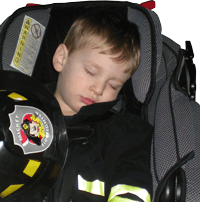Child Safety Seat Program
Child safety seats and safety belts, when installed and used properly, can prevent injuries and save lives. Each year, an estimated 975 child occupants under 14 years of age die as a result of a motor vehicle incident. Young children restrained in child safety seats have an 80 percent lower risk of fatal injury than those who are unrestrained.

What You Can Do:
- Set an appointment with a High Ridge Fire Car Seat Technician to have your child safety seats checked. You will need to bring the vehicle that you would like to have the seat installed in, the vehicles owners manual, the child’s safety seat and all provided hardware and manual. If you believe the seat is installed safely you may bring the child to the appointment so the restraints may be fitted to the child.
- Always ensure that every occupant is properly restrained for every ride.
- Always follow manufacturer’s instructions.
- Call High Ridge Fire District today to schedule an appointment 636-677-3371
Growing Up Safe - It’s a four-step process

For the best possible protection keep infants in the back seat, in the rear-facing child safety seats, as ling as possible up to the height or weight limit of the particular seat. At a minimum, keep infants rear-facing until a minimum of age 1 and at least 20 pounds.

When children outgrow their rear-facing seats (at a minimum age 1 and at least 20 pounds) they should ride in forward-facing child safety seats, in the back seat, until they reach the upper weight or height limit of the particular seat (usually around age 4 and 40 pounds).

Once children outgrow their forward=facing seats (usually around age 4 and 10 pounds), they should ride in booster seats, in the backseat, until the vehicle seat belts fit properly. Seat belt fits across the chest (usually at age 8 or when they are 4’9″ tall).

When children outgrow their booster seats, (usually at age 8 or wen they are 4’9″ tall) they can use the adult seat belt in the back seat, if it fits properly (lap belt lays across the upper thighs and the shoulder belt fits across the chest).
Updated Recommendations for Rear-Facing Carseats
“The AAP recommends that all infants should ride rear-facing starting with their first ride home from the hospital. All infants and toddlers should ride in a Rear-Facing Car Safety Seat until they are 2 years of age or until they reach the highest weight or height allowed by their car safety seat’s manufacturer.” – AAP: American Academy of Pediatrics, Car Safety Seats: Information for Families for 2011
“Keep your child rear-facing as long as possible. It’s the best way to keep him or her safe. Your child should remain in a rear-facing car seat until he or she reaches the top height or weight limit allowed by your car seat’s manufacturer. Once your child outgrows the rear-facing car seat, your child is ready to travel in a forward-facing car seat with a harness.”- NHTSA: National Highway Traffic Safety Administration, Growing Up Safe: It’s a four-step process. (publication: 4 Steps Flyer)
“For the best possible protection, keep your infant in a rear-facing child safety seat in a back seat for as long as possible – up to the height or weight limit of the particular seat. The “12 months and 20 pounds” rule many parents cite when turning their child forward-facing in the car is actually the minimum size and age requirement for that changes” – Safe Kids Worldwide
Every Child Deserves to be Safe
The High Ridge Fire District believes that the cost of a carseat should never have to be a factor in deciding to protect your child. To aid in making sure that all children are safe while rising in a vehicle, we have developed a program for providing and installing child passenger seats at little to no cost.